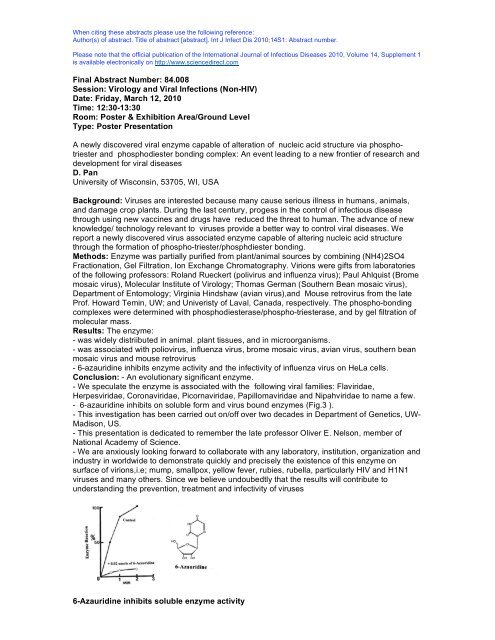14th ICID - Poster Abstracts - International Society for Infectious ...
14th ICID - Poster Abstracts - International Society for Infectious ...
14th ICID - Poster Abstracts - International Society for Infectious ...
You also want an ePaper? Increase the reach of your titles
YUMPU automatically turns print PDFs into web optimized ePapers that Google loves.
When citing these abstracts please use the following reference:<br />
Author(s) of abstract. Title of abstract [abstract]. Int J Infect Dis 2010;14S1: Abstract number.<br />
Please note that the official publication of the <strong>International</strong> Journal of <strong>Infectious</strong> Diseases 2010, Volume 14, Supplement 1<br />
is available electronically on http://www.sciencedirect.com<br />
Final Abstract Number: 84.008<br />
Session: Virology and Viral Infections (Non-HIV)<br />
Date: Friday, March 12, 2010<br />
Time: 12:30-13:30<br />
Room: <strong>Poster</strong> & Exhibition Area/Ground Level<br />
Type: <strong>Poster</strong> Presentation<br />
A newly discovered viral enzyme capable of alteration of nucleic acid structure via phosphotriester<br />
and phosphodiester bonding complex: An event leading to a new frontier of research and<br />
development <strong>for</strong> viral diseases<br />
D. Pan<br />
University of Wisconsin, 53705, WI, USA<br />
Background: Viruses are interested because many cause serious illness in humans, animals,<br />
and damage crop plants. During the last century, progess in the control of infectious disease<br />
through using new vaccines and drugs have reduced the threat to human. The advance of new<br />
knowledge/ technology relevant to viruses provide a better way to control viral diseases. We<br />
report a newly discovered virus associated enzyme capable of altering nucleic acid structure<br />
through the <strong>for</strong>mation of phospho-triester/phosphdiester bonding.<br />
Methods: Enzyme was partially purified from plant/animal sources by combining (NH4)2SO4<br />
Fractionation, Gel Filtration, Ion Exchange Chromatography. Virions were gifts from laboratories<br />
of the following professors: Roland Rueckert (polivirus and influenza virus); Paul Ahlquist (Brome<br />
mosaic virus), Molecular Institute of Virology; Thomas German (Southern Bean mosaic virus),<br />
Department of Entomology; Virginia Hindshaw (avian virus),and Mouse retrovirus from the late<br />
Prof. Howard Temin, UW; and Univeristy of Laval, Canada, respectively. The phospho-bonding<br />
complexes were determined with phosphodiesterase/phospho-triesterase, and by gel filtration of<br />
molecular mass.<br />
Results: The enzyme:<br />
- was widely distriibuted in animal. plant tissues, and in microorganisms.<br />
- was associated with poliovirus, influenza virus, brome mosaic virus, avian virus, southern bean<br />
mosaic virus and mouse retrovirus<br />
- 6-azauridine inhibits enzyme activity and the infectivity of influenza virus on HeLa cells.<br />
Conclusion: - An evolutionary significant enzyme.<br />
- We speculate the enzyme is associated with the following viral families: Flaviridae,<br />
Herpesviridae, Coronaviridae, Picornaviridae, Papillomaviridae and Nipahviridae to name a few.<br />
- 6-azauridine inhibits on soluble <strong>for</strong>m and virus bound enzymes (Fig.3 ).<br />
- This investigation has been carried out on/off over two decades in Department of Genetics, UW-<br />
Madison, US.<br />
- This presentation is dedicated to remember the late professor Oliver E. Nelson, member of<br />
National Academy of Science.<br />
- We are anxiously looking <strong>for</strong>ward to collaborate with any laboratory, institution, organization and<br />
industry in worldwide to demonstrate quickly and precisely the existence of this enzyme on<br />
surface of virions,i.e; mump, smallpox, yellow fever, rubies, rubella, particularly HIV and H1N1<br />
viruses and many others. Since we believe undoubedtly that the results will contribute to<br />
understanding the prevention, treatment and infectivity of viruses<br />
6-Azauridine inhibits soluble enzyme activity
















